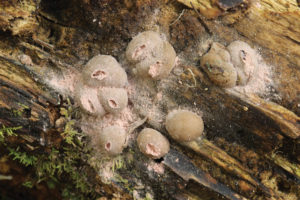Slime moulds have baffled naturalists and scientists for centuries. In about 1750 when Swedish botanist Carl Linnaeus was devising his system of classification, he decided there were two kingdoms: plants and animals. Fungi (including slime moulds that were thought to be fungi at the time) were lumped in with the plants.
When it was clear that fungi were different from plants, the fungi kingdom was added and slime moulds were included. When it was confirmed that slime moulds had a moving feeding stage, they went into the animal kingdom, but they were moved yet again when their amoeboid stage was observed. They are now in the kingdom Protista (or Protoctista), a dumping ground for a very diverse array of microorganisms that are neither plant, animal nor fungus.
In 1905 The Botanical Congress in Vienna set the starting point of the nomenclature of the myxomycetes (and most other organisms) to 1753, the year of publication of Linnaeus Species Plantarum. Two species of relatively large slime mould species were described in the first edition in 1753 —Lycoperdon (now Lycogala) epidendrum and Clathrus (now Arcyria) denudata. The two in the second edition in 1763 were Lycoperdon (now Diderma) radiatum and Mucor (now Fuligo) septica. (Fungimappers will be familiar with the fungi names used at the time for the slime moulds.)

Lycogala epidendrum was possibly the first slime mould to be illustrated. Even before Linnaeus put it in the genus Lycoperdon because of its similarity to puffball fungi, it had been illustrated and described by Panckow in 1654. The species remained Lycoperdon and was associated with fungi until the end of the 18th century. This was despite Micheli proposing the genus Lycogala and demonstrating in 1729 the important differences from the Gasteromycetes (puffballs and similar).
(N.B. It is very likely that Lycogala found in Australia are not epidendrum.)
In 1833 German naturalist and botanist Johann Heinrich Friedrich Link perceived them as a group separate from the fungi and created the name myxomycetes (Gk myxo slime; myketes fungi).
In about 1850 with improvements to the microscope, it was obvious that slime moulds were closer to amoeboid protists than fungi in structure and life cycle. The name “mycetozoa” was proposed — “myketes” to reflect the fungus-like fruiting bodies, and “zoa” to reflect the animal-like motile cells.
From the mid-20th century, “myxomycetes” has been the name used in almost all the literature, but slime moulds are still included in American college texts as fungi, probably because they have traditionally been studied by mycologists.
In 2005 the international society of protistologists classified acellular Slime moulds (Myxomycetes) as Myxogastrids in the superclass Amoebozoa. However, the International Code for Zoological Nomenclature (ICZN) calls slime moulds “Myxogastrids” whereas the International Code for nomenclature for algae, fungi and plants (ICN) calls them “Myxomycetes”. Confused?
Notice the names used in the introduction to the new on-line free-access journal devoted to Slime Molds. The first issue is due to be published in July 2021. Anyone can contribute!
“Slime Molds is a journal dedicated to mycetozoans (myxomycetes, dictyostelids and other amoeboid organisms). It is a project with the premise of disseminating as much as possible the scientific, artistic, educational and technological outcomes of the human interest in these organisms. This initiative was conceived by professional researchers and enthusiasts of slime molds and it represents a democratic and free-of-cost space for the publication of items of general interest to the community. Everybody is welcome to publish on Slime Molds anything considered relevant for the continuous construction of knowledge and appreciation of these microscopic organisms.” https://slimemolds.org/
Text and images by Sarah Lloyd OAM
For more information
Lado, C. & Eliasson, U. (2017) Taxonomy and Systematics: current knowledge and
approaches on the taxonomic treatment of myxomycetes. In Stephenson, SL & Rojas, C.
Myxomycetes: Biology, Systematics, Biogeography and Ecology, Elsevier, London.
Lloyd, SJ, (2020) Where the slime mould creeps. 3rd edition. Tympanocryptis Press,
Birralee.
https://en.wikipedia.org/wiki/Myxogastria accessed 26 June 2021
https://en.wikipedia.org/wiki/Protist accessed 27 June 2021
Please note, Sarah Lloyd OAM has published several books on slime moulds, and Where the slime mould creeps (3rd edition) and Myxomycetes at Black Sugarloaf, Tasmania, Australia are currently available from the Fungimap bookshop, together with her Myxomycetes posters and postcard sets.

